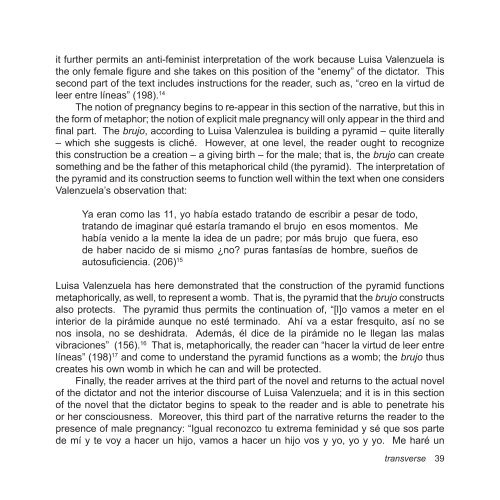Untitled - Centre for Comparative Literature - University of Toronto
Untitled - Centre for Comparative Literature - University of Toronto
Untitled - Centre for Comparative Literature - University of Toronto
Create successful ePaper yourself
Turn your PDF publications into a flip-book with our unique Google optimized e-Paper software.
it further permits an anti-feminist interpretation <strong>of</strong> the work because Luisa Valenzuela is<br />
the only female fi gure and she takes on this position <strong>of</strong> the “enemy” <strong>of</strong> the dictator. This<br />
second part <strong>of</strong> the text includes instructions <strong>for</strong> the reader, such as, “creo en la virtud de<br />
leer entre líneas” (198). 14<br />
The notion <strong>of</strong> pregnancy begins to re-appear in this section <strong>of</strong> the narrative, but this in<br />
the <strong>for</strong>m <strong>of</strong> metaphor; the notion <strong>of</strong> explicit male pregnancy will only appear in the third and<br />
fi nal part. The brujo, according to Luisa Valenzulea is building a pyramid – quite literally<br />
– which she suggests is cliché. However, at one level, the reader ought to recognize<br />
this construction be a creation – a giving birth – <strong>for</strong> the male; that is, the brujo can create<br />
something and be the father <strong>of</strong> this metaphorical child (the pyramid). The interpretation <strong>of</strong><br />
the pyramid and its construction seems to function well within the text when one considers<br />
Valenzuela’s observation that:<br />
Ya eran como las 11, yo había estado tratando de escribir a pesar de todo,<br />
tratando de imaginar qué estaría tramando el brujo en esos momentos. Me<br />
había venido a la mente la idea de un padre; por más brujo que fuera, eso<br />
de haber nacido de si mismo ¿no? puras fantasías de hombre, sueños de<br />
autosufi ciencia. (206) 15<br />
Luisa Valenzuela has here demonstrated that the construction <strong>of</strong> the pyramid functions<br />
metaphorically, as well, to represent a womb. That is, the pyramid that the brujo constructs<br />
also protects. The pyramid thus permits the continuation <strong>of</strong>, “[l]o vamos a meter en el<br />
interior de la pirámide aunque no esté terminado. Ahí va a estar fresquito, así no se<br />
nos insola, no se deshidrata. Además, él dice de la pirámide no le llegan las malas<br />
vibraciones” (156). 16 That is, metaphorically, the reader can “hacer la virtud de leer entre<br />
líneas” (198) 17 and come to understand the pyramid functions as a womb; the brujo thus<br />
creates his own womb in which he can and will be protected.<br />
Finally, the reader arrives at the third part <strong>of</strong> the novel and returns to the actual novel<br />
<strong>of</strong> the dictator and not the interior discourse <strong>of</strong> Luisa Valenzuela; and it is in this section<br />
<strong>of</strong> the novel that the dictator begins to speak to the reader and is able to penetrate his<br />
or her consciousness. Moreover, this third part <strong>of</strong> the narrative returns the reader to the<br />
presence <strong>of</strong> male pregnancy: “Igual reconozco tu extrema feminidad y sé que sos parte<br />
de mí y te voy a hacer un hijo, vamos a hacer un hijo vos y yo, yo y yo. Me haré un<br />
transverse 39




